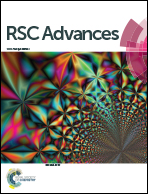Thermo-responsive amino acid-based vinyl polymers showing widely tunable LCST/UCST behavior in water†
Abstract
We report a thermo-responsive polymer system showing widely tunable UCST/LCST behaviors based on amino acid-derived vinyl polymers. Four amino acids of Gly, Ala, Phe and Val and their methyl esters were employed for preparation of vinyl polymers, by considering hydrophobicity of the side chain group. The water solubility of these polymers was first examined, and as a result most of the polymers were soluble in water at a neutral pH, except the methylated Phe-based polymer and the Val-based polymers. The COOH-carrying Ala-based polymer displayed an upper critical solution temperature (UCST) behavior in water below pH 2.0 due to thermo-reversible hydrogen bonding of the pendent COOH groups, while the Gly-based polymer did not show any phase separation. The methylation of such COOH groups induced a lower critical solution temperature (LCST) behavior. Widely tunable UCST/LCST behaviors were achieved between 18 °C and 73 °C by using copolymers from different monomer combinations. Cross-linking of methylated Ala-based polymers gave a thermo-reversible hydrogel, which exhibited swelling and deswelling transitions at around the same temperature as the LCST of the corresponding homopolymer.


 Please wait while we load your content...
Please wait while we load your content...